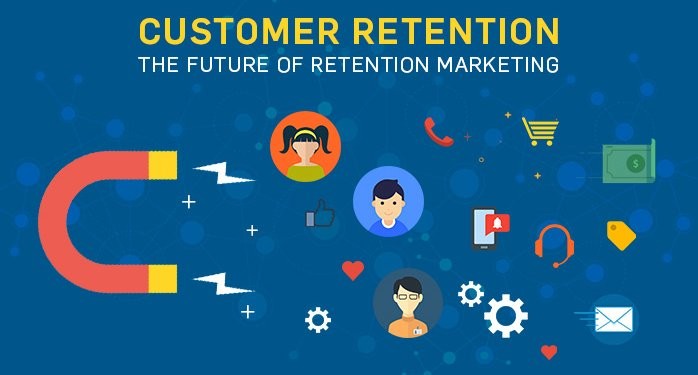Retention marketing isn’t a new strategy, but it’s definitely one that deserves a bit more love and attention. It’s the spirit behind the notion that it’s more valuable to have 10 brand fanatics rather than 100 loosey-goosey customers. The 100 flaky customers might all make a purchase once in a lifetime, but your brand loyalists will buy for themselves, their kids, their neighbor, their aunt, and maybe (just maybe) their dog.
While acquiring a new customer no longer costs 5–25x more than retaining an old one (like it used to), the lesson behind the rule remains the same—it’s cheaper to keep loyal customers rather than chase down new ones.
Marketing without retention is pushing customers into your funnel, through the checkout line, and out the back door. It’s crazy, but when put in that perspective, that’s the trap many businesses fall into—constantly throwing money at brand-new eyeballs and potential buyers rather than focusing on lifetime customers and repeat purchases.

What is retention marketing?
Retention marketing is the strategies and tactics you use to nurture and maintain your relationships with customers. Ecommerce isn’t the only industry doing it, either—everyone from big-time enterprises to mom-and-pop shops does it to keep customers coming back for more.
For example, when Uber sends you a push notification with a $5 coupon, it’s hitting you with a retention marketing strategy. And when your local pizza joint invites you back with a text message for a buy-one-get-one pie, it’s using retention marketing.
Retention marketing tactics could include other activities, such as:
- Warm welcome emails with additional resources or tips that help your recipients with the onboarding workflow
- Exclusive VIP offers for loyal and consistent users or customers
- Loyalty programs that reward customers for spending more
- Regular newsletters that include a combination of educational content and promotional pieces
- Reengagement emails with links to your preference center to allow recipients to customize their email frequency
But email isn’t the only way to do retention marketing. As we mentioned before, you could use SMS, push notifications, voice, chat, video, social media, and more to engage and retain your customer base—more on that soon.
Customer retention marketing vs. customer acquisition
So what’s the difference between customer retention marketing and customer acquisition? We’re glad you asked.
Customer acquisition is the marketing practices you use to find brand-new customers. It includes the strategies you use to keep previous and current customers.
For example, your company might launch a new downloadable guide to collect new leads for the sales team. That’s customer acquisition marketing.
On the other side, you might have a brand-new customer who opts into your email list at checkout. A week later, you send them a follow-up to see how they’re doing with their new product and ask if they have any questions—that’s an example of retention marketing.
Best retention marketing channels
- Email: Email is one of the few opt-in channels. Your customers give you their email address and check a box (or should) to confirm they want your messages. Then, you can use their email to follow up with 1:1 conversations, upsell opportunities, and more.
- PPC: Pay-per-click ads is one way to retarget your customers. For example, if a customer buys a 30-serving supplement from your business, you might start sending them ads for the same product (or similar products) 30 days after they received their first purchase.
- SMS: SMS is another opt-in-only retentional marketing channel. It has a higher open rate than email, but most consumers guard their phone numbers more than their email addresses. So when a customer gives you their number, treat it with respect—it can do you a lifetime of good if you use it properly.
- Social media: Social media is all about building relationships. Use your social media profiles to transform your existing customers into followers and your followers into brand loyalists.
- Push notifications: Push notifications can be a great way to remind your customers to revisit your app or make a repeat purchase. Use them sparingly to prevent annoying your customers and losing notification privileges.
FAQs
What's a good retention rate in marketing?
While you shouldn’t necessarily treat these numbers as gospel, here are a few industry benchmarks to give you an idea of a good customer retention rate in marketing:
- Most industries can expect an average of below 20% retention in 8 weeks.
- SaaS and ecommerce industries can see over a 35% retention rate in 8 weeks.
- Media or finance industries can reach over a 25% retention rate in 8 weeks.
Retention marketing best practices to keep in mind?
- Honor opt-ins: Messaging any customer who hasn’t given you explicit consent to communicate with them is a big no-no. Just because your buyer entered their email address to complete a purchase doesn’t mean you can start blasting them with emails—they need to opt in first.
- Respect breakups: Breakups happen. It sucks, but it happens. Sometimes, customers will choose another brand over yours despite your best marketing efforts—and that’s OK. That doesn’t mean you’ve done something wrong. It just means they found a better fit elsewhere. Give them their space, remove them from your email lists (if they’ve unengaged), and let time (potentially) do the healing.
- Experiment: Your first idea might not be your best idea, but you won’t know that until you test new things out. Experiment with new retention marketing channels and tactics to see if one resonates better with your audience. Does it engage customers? If so, scale it. If it doesn’t, move on to the next idea.
- Monitor: With the right software, systems, and processes, you can track your retention marketing performance. If customer churn decreases, you want to know what worked to replicate success. Identify the metrics you care most about (customer lifetime value, repeat purchases, referrals, etc.) and monitor them closely.
- Incentivize: Just because you build it does not mean they’ll come. Find incentives that deliver real value to your customers to entice them to remain loyal to your brand. When you focus on customer satisfaction (and not sales), you’ll usually head in the right direction.
Practice area's of B K Goyal & Co LLP
Income Tax Return Filing | Income Tax Appeal | Income Tax Notice | GST Registration | GST Return Filing | FSSAI Registration | Company Registration | Company Audit | Company Annual Compliance | Income Tax Audit | Nidhi Company Registration| LLP Registration | Accounting in India | NGO Registration | NGO Audit | ESG | BRSR | Private Security Agency | Udyam Registration | Trademark Registration | Copyright Registration | Patent Registration | Import Export Code | Forensic Accounting and Fraud Detection | Section 8 Company | Foreign Company | 80G and 12A Certificate | FCRA Registration |DGGI Cases | Scrutiny Cases | Income Escapement Cases | Search & Seizure | CIT Appeal | ITAT Appeal | Auditors | Internal Audit | Financial Audit | Process Audit | IEC Code | CA Certification | Income Tax Demand Notice | Psara License | FCRA Online
Company Registration Services in major cities of India
Company Registration in Jaipur | Company Registration in Delhi | Company Registration in Pune | Company Registration in Hyderabad | Company Registration in Bangalore | Company Registration in Chennai | Company Registration in Kolkata | Company Registration in Mumbai | Company Registration in India | Company Registration in Gurgaon | Company Registration in Noida | Company Registration in lucknow
Most read resources
tnreginet |rajssp | jharsewa | picme | pmkisan | webland | bonafide certificate | rent agreement format | tax audit applicability | 7/12 online maharasthra | kerala psc registration | antyodaya saral portal | appointment letter format | GST Search Taxpayer | caro 2020 | Challan 280 | itr intimation password | internal audit applicability | preliminiary expenses | mAadhar | e shram card | aaple sarkar portal | epf activation | scrap business | brsr | depreciation on computer | west bengal land registration | traces portal | Directorate general of GST Intelligence | form 16 | rtps | patta chitta
